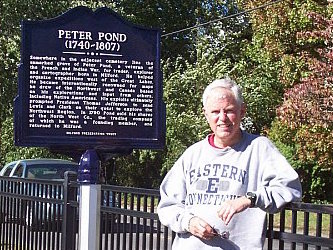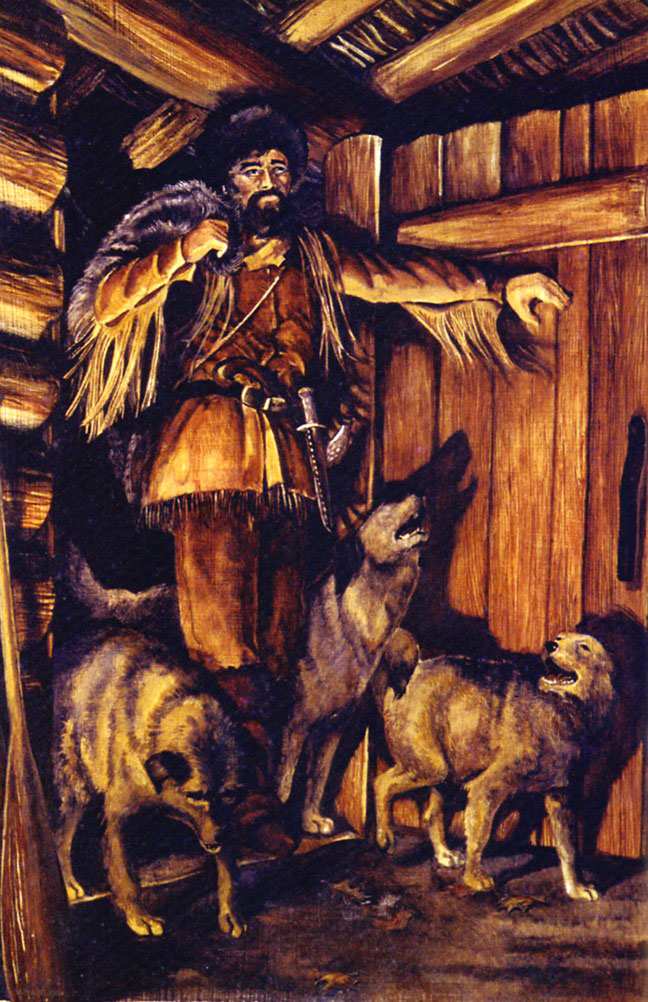Peter Pond newsletter :: May 2007 :: #29
MORE FROM DUCKWORTH
Further to that discussed in Peter Pond Society28, the likelihood Peter Pond had both a Milford wife with family and country wife counterpart, here is "The English River Book" editor Harry Duckworth of University of Manitoba again.
"Dear Bill:
Thanks very much for all the material on Augustus Pond and his family. I read Newsletter No. 28 with great interest, and was pleasantly embarrassed by your much too flattering comments on my work in The English River Book. Thank you very much. As my father used to say, the fact that the words were undeserved takes nothing away from the pleasure hearing (reading) them.
One thing I noticed in Sandy Rathwell's genealogy account, but it's taken me awhile to figure out what it means, is the fact that Augustin Pond was known as "Robesca/Robescar", and three of his sons were known by a name that appears as "Rebouscaw", "Rebaskaw", or "Ravasca/Atha-Gaska". This word must be "Arabaska", a well-attested variant form of Athabasca, the large rich fur district that Peter Pond discovered in 1779. The Pond family in northern Michigan seem to have been using this as a sort of extra surname, what the French-Canadian genealogists call a "dit" name. These extra surnames were used in Quebec to distinguish between persons whose names would otherwise have been identical, due to the small number of given names and surnames in use in French Canada. An example would be Joseph Landry dit Cadien, ie Joseph Landry called "Cadien" or Acadien. There are many examples, and Quebec genealogists have to be familiar with them, since sometimes only the dit name is used in some records.
The surname Pond, of course, was not common in Quebec, but the family might have added "Arabaska" as a way of emphasizing their ancestor's distinguished accomplishments.
Whatever the exact explanation, the fact that this name was used is a further confirmation that Augustin Pond was Peter Pond's son.
I hope you find this of interest.
All the best,
Harry"
WELCOME SENATOR WHITEHOUSE

Senator Sheldon Whitehouse letter
You remember I wrote congratulations to U.S. Senator Sheldon Whitehouse (Democrat, Rhode Island) on his election victory last fall. I also enclosed a copy of his fine tribute to the Rev. Peter Pond after his death in June 2000. Sheldon graciously responded and asked to be placed among the rest of you receiving the newsletter.
FAIRLEE 2007

Geoffrey Burke, me, Deb Williams, Judy Pond and David Chapin

John Ledyard plaque
I enjoyed attending the Wilderness Paddlers Gathering at Hulbert Outdoor Center in Fairlee, Vermont the weekend of March 9-11. Peter Pond Society member Judy Pond let me stay at her house in Norwich 10 miles away. We drove up Friday night and Saturday morning to 30-minute wilderness paddling slide shows along with an afternoon of outdoor skill presentations, and more slides that night. It was basically hog heaven of rubbing elbows with like-minded people, during which time eight new Peter Pond Society members were added. That brings membership to an all-time high of 155! When do you think I should start charging dues?

John Ledyard bridge

Michael Kohout making a birch bark canoe
Conference Director Deb Williams sent me a list of presenters over the years since 1993 and I see Peter Pond Societyers Max Finkelstein, Michael Peake and Jim Dina are among them. Among the eight acquired this weekend is David Chapin of Nottingham, N.H., a PhD and former college English professor currently working on a book about Peter Pond. He is also an accomplished outdoorsman who both narrated a slide show on leading a group of teenagers for a two-week Canadian paddle trip and gave a demonstration on tumping, basically carrying a 100-lb. provision box or 70-lb. canoe supported by a thick leather strap across the top of his head. I include shots of the nearby plaque and bridge dedicated to 18th century explorer John Ledyard, a Dartmouth dropout whom the college has cherished over the years. And since Peter Pond is all about birch bark canoes, new Peter Pond Societyer Michael Kohout of nearby Dummerston explained how to make one.
After discussing in Peter Pond Society 27 the classic staple of voyageur nourishment, pemmican, you should not be surprised that I soon whipped up some of my own and ate it. It came thru a simple recipe from Karl Koster, Peter Pond Society member and interpreter at the Grand Portage Museum in Minnesota.
How did it taste? As Karl warned, not that good but not that bad. The recipe is pretty simple: mix animal fat in with dried meat, a concoction when ready has been known to stay edible for years. So going by Koster's recipe, I bought beef suet (popular in bird feeders) at the local meat counter for something like 50 cents. Karl said best place for dried beef was at an Asian food store. I went to one and all they had was dried or shredded pork, saying beef wasn't that popular and more apt to be made at home. So I melted the suet in a frying pan, poured the liquid into a bowl and mixed in the shredded pork. I then poured the mixture into several paper cupcake forms in a cupcake tin, let cooled and there it was, pemmican in the form of a bite-sized wafer. It tasted like shredded pork wrapped in fat, but I didn't get sick. So like many other adventures, I can say I did it at least once. As Karl says in his lengthy article of Peter Pond Society 27, it was the Power Bar of its day.
Now here's an interesting article on how pemmican (the real stuff, made with beef) is treated in the north these days, still apparently popular. Once again, from Jim McPerson of Hay River, NWT, on the shores of Great Slave Lake, the one whose father ran the "Peter Pond" boat as freighter and passenger service for years. You'll also see he weighs in on mosquitoes, comment on which comes first.
"Hi Bill- I read with interest your articles on both mosquitoes and pemmican. I am familiar with both having been born and raised in the North. Mosquitoes are a horrible pestilence and without the application of gallons of deet we would indeed be walking skeletons due to lack of blood. I grew up among the chipweyans Indians and a common method of resisting these pests would be to smear oneself with certain types of clay or mud. It would be applied in successive layers and allowed to dry on the exposed parts of your anatomy. I have tried it myself and it is quite effective although movement would allow the clay to crack and peel off. It is best at night when your movement is limited. When you are desperate you will try anything. Black flies are undoubtedly the worst pests but keeping a large brim hat over your face and walking into the wind is effective. They do not seem to like the shaded areas. I would always try to find a windy spot to camp when I am out on the land, a high hill or windy point on a lake. Burning willow branches provides some protection, but a man can only handle so much wood smoke and you are in danger of dying from smoke inhalation. I have found deep woods off to be the most effective modern repellant. It is not effective against black flies however.
Pemmiccan; or dry meat as it is known locally it quite popular here and I have eaten it all my life and have developed a taste for it. I prefer it raw or with nothing mixed with it. Many of the native people eat it with large portions of animal fat (raw), a chunk of dry meat followed by a chunk of animal fat. Mmmm MMMm good as they say! It is very seldom made into a mixture of pounded meat and berries although I have tried it this way. It is actually quite tasty, depending upon the berries used, but it requires a lot more labour to produce. Dry meat is quite a lucrative business up here and approx two pounds will sell for about $40.00 canadian (about $10.00 american.) The most common animal is barren ground caribou, but moose is quite popular and bison is way down on the list. I know people that make a decent living just making and selling dry meat or pemmican. A skilled person can process a 100 lb. caribou in one day from kill to sales. It must be kept dry and it is most often sold in paper bags. Plastic must not be used as it will retain moisture and this must be avoided at all costs. I would think that many of the early explorers did not keep their pemmican dry and lost it as a result of moisture as it will rot very quickly. Just some trivial information for you. Coincidentally I spent several days last summer camped near old Ft. Providence where Peter Pond spent some time. It has been declared a heritage site and is off limits to the general public.
Cheers
Jim- Colder than hell here right now minus 31 last night! Celcius."
I have permission to show Peter Pond Society members this wonderful website.
It's published by the office of Connecticut State Historian. Click on it and follow the instructions. You will find wonderful historical discussions not just pertaining to Connecticut, blogs and websites on all sorts of topics and you will be getting emailings of whatever new and interesting info someone finds. There is an area for Canadian topics as well.

Au revoir,
Bill
website design by Daniel Ortoleva
